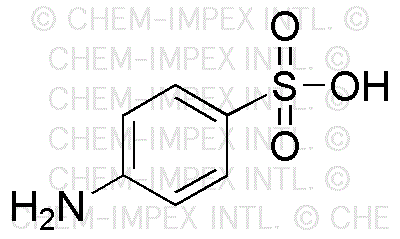Sulfanillic acid is widely utilized in research focused on:
- Pharmaceutical Development: It serves as a key intermediate in the synthesis of various drugs, particularly sulfa drugs, which are essential in treating bacterial infections.
- Analytical Chemistry: This compound is used in colorimetric assays to detect and quantify nitrites and nitrates in environmental samples, providing crucial data for water quality assessments.
- Dyes and Pigments: Sulfanillic acid is employed in the production of azo dyes, which are widely used in textiles and food industries, offering vibrant colors and stability.
- Biochemistry: It acts as a reagent in biochemical assays, facilitating enzyme activity studies and metabolic pathway research, thus aiding in the understanding of cellular processes.
- Water Treatment: The compound is utilized in the formulation of certain water treatment chemicals, helping to remove contaminants and improve water quality for industrial applications.
General Information
Properties
Safety and Regulations
Applications
Sulfanillic acid is widely utilized in research focused on:
- Pharmaceutical Development: It serves as a key intermediate in the synthesis of various drugs, particularly sulfa drugs, which are essential in treating bacterial infections.
- Analytical Chemistry: This compound is used in colorimetric assays to detect and quantify nitrites and nitrates in environmental samples, providing crucial data for water quality assessments.
- Dyes and Pigments: Sulfanillic acid is employed in the production of azo dyes, which are widely used in textiles and food industries, offering vibrant colors and stability.
- Biochemistry: It acts as a reagent in biochemical assays, facilitating enzyme activity studies and metabolic pathway research, thus aiding in the understanding of cellular processes.
- Water Treatment: The compound is utilized in the formulation of certain water treatment chemicals, helping to remove contaminants and improve water quality for industrial applications.
Documents
Safety Data Sheets (SDS)
The SDS provides comprehensive safety information on handling, storage, and disposal of the product.
Product Specification (PS)
The PS provides a comprehensive breakdown of the product’s properties, including chemical composition, physical state, purity, and storage requirements. It also details acceptable quality ranges and the product's intended applications.
Certificates of Analysis (COA)
Search for Certificates of Analysis (COA) by entering the products Lot Number. Lot and Batch Numbers can be found on a product’s label following the words ‘Lot’ or ‘Batch’.
*Catalog Number
*Lot Number
Certificates Of Origin (COO)
This COO confirms the country where the product was manufactured, and also details the materials and components used in it and whether it is derived from natural, synthetic, or other specific sources. This certificate may be required for customs, trade, and regulatory compliance.
*Catalog Number
*Lot Number
Safety Data Sheets (SDS)
The SDS provides comprehensive safety information on handling, storage, and disposal of the product.
DownloadProduct Specification (PS)
The PS provides a comprehensive breakdown of the product’s properties, including chemical composition, physical state, purity, and storage requirements. It also details acceptable quality ranges and the product's intended applications.
DownloadCertificates of Analysis (COA)
Search for Certificates of Analysis (COA) by entering the products Lot Number. Lot and Batch Numbers can be found on a product’s label following the words ‘Lot’ or ‘Batch’.
*Catalog Number
*Lot Number
Certificates Of Origin (COO)
This COO confirms the country where the product was manufactured, and also details the materials and components used in it and whether it is derived from natural, synthetic, or other specific sources. This certificate may be required for customs, trade, and regulatory compliance.


